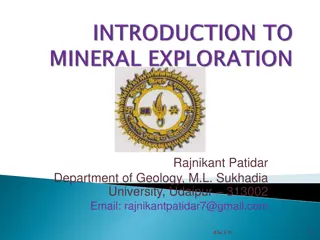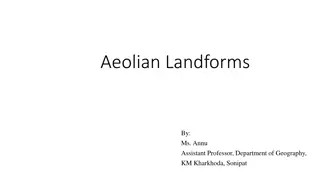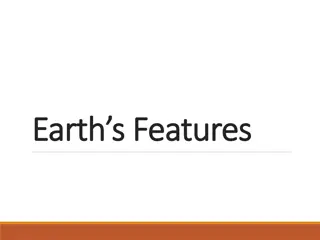The Geology of the United States: Overview of Major Provinces and Landforms
The geology of the United States is diverse and fascinating, organized into 10 key geologic provinces along with Hawaii and Alaska. Orogeny processes have shaped the land over time, adding new land to the Precambrian craton. Geologic maps depict the location and age of rocks in the uppermost crust using colors and symbols. Specific provinces like the Coastal Plain and Appalachian Highlands have unique origins and characteristics, reflecting the geological history of the region.
Download Presentation

Please find below an Image/Link to download the presentation.
The content on the website is provided AS IS for your information and personal use only. It may not be sold, licensed, or shared on other websites without obtaining consent from the author.If you encounter any issues during the download, it is possible that the publisher has removed the file from their server.
You are allowed to download the files provided on this website for personal or commercial use, subject to the condition that they are used lawfully. All files are the property of their respective owners.
The content on the website is provided AS IS for your information and personal use only. It may not be sold, licensed, or shared on other websites without obtaining consent from the author.
E N D
Presentation Transcript
The Geology Of The United States
The United States Is Organized into 10 Geologic Provinces plus Hawaii and Alaska. Rocky Mountain System Laurentian Upland Columbia Plateau Interior Plains Pacific Mountain System Interior Highlands Colorado Plateau Appalachian Highlands Basin and Range Coastal Plain
Orogeny added added new land to the Precambrian craton through Continental Accretion.
On Geologic Maps, colors are used to depict the location and age of rocks that form the uppermost crust. Symbols are used to depict the lithology. The Geologic Map of the United States compiled by P.B. King and H.M. Beikman
The Coastal Plain Province Is Composed of Young, Thick Sedimentary Rocks
Coastal Plain Originated with the breakup of Pangaea. Passive margin of the North American Plate. Sediments up to 15 km in thickness. Eroded Appalachian Highland Sediments were deposited in deltas, estuaries, barrier islands, and other coastal and marine environments.
Florida Peninsula Originated with the breakup of Pangaea Florida Platform developed - a carbonate platform on a block of crystalline crustal rock. Siliciclastic Appalachian sediments eventually filled in a deep trough between the platform and the mainland of the United States.
The Appalachian Highland Province Has Been Evolving since the Precambrian Eon.
Appalachian Highlands Originated during the Paleozoic: Taconic Orogeny Acadian Orogeny Alleghenian Orogeny Mountain system consisting of numerous ranges.
Appalachian Highlands Subdivided into four distinct regions: Piedmont Blue Ridge Valley and Ridge Appalachian Plateau Isostatic rebound during the Cenozoic.
The Laurentian Upland Province Contains the Oldest Rocks in the Nation
Laurentian Upland Part of the Canadian Shield. Belts of volcanic and sedimentary rocks metamorphosed to greenschist, separated by belts of granitic rock. Seafloor rifting ~2.7 bya caused metamorphism. Glaciated during the Quaternary by the Laurentide Ice Sheet.
The Last ice Age 20,000 to 25,000 years ago
The Interior Plains and Interior Highlands Consist of Exposed Paleozoic and Mesozoic Rocks Ordovician Period
Interior Plains Broad, generally flat area of the central United States between the Rocky Mountains and the Appalachians. Mostly composed of flat-lying or gently dipping sedimentary strata: Paleozoic sediments deposited in the east. Mesozoic sediments deposited in the west. Accumulated sediments buried the interior stable platform of the craton.
Western Interior Seaway, Cretaceous Period
Interior Highlands Parts of Texas, Oklahoma, Arkansas, and Missouri. Composed of sequences of folded Paleozoic sedimentary rocks. Originated in the formation of Pangaea. High levels of deformation in the Ouachita Orogenic Belt. Distinctive from adjacent provinces for high relief and topographic elevation.
Ouachita and Appalachian Orogenic Belts
Crust in the Rocky Mountain System Dates from the Proterozoic to the Late Phanerozoic Eons.
Rocky Mountain System Midcontinent portion of North American Cordillera. Covered by shallow seas during the early Paleozoic. Ancestral Rocky Mountains created during convergence of Gondwanaland and North America. Uncompahgre Uplift Amarillo-Wichita-Arbuckle Uplift Front Range Pedernal Uplift Modern Rocky Mountains created by the Laramide Orogeny. Current topography result of erosion after Neogene uplift and "sculpting" during Quaternary glaciation.
North American Plate (Mesozoic early Cenozoic) crustal "shortening" in the west, extension in the east
The Colorado Plateau Is Composed of Uplifted Phanerozoic Strata.
Colorado Plateau Originated with the formation of Rodinia. Eroded to a flat, nearly featureless surface by ~600 mya. Sediments from western highlands deposited in the region during the Jurassic and Cretaceous. Widespread volcanism during the Mesozoic. Last marine deposits are Cretaceous. Uplifted by subduction of Farallon Plate in the Neogene. Modern stream drainage established in Neogene.
The Basin and Range and Columbia Plateau Provinces Were Formed during the Cenozoic Era
Basin and Range Province Unique topography produced by normal faulting. Basins are down-faulted blocks of crust (grabens) Ranges are up-thrusted slabs (horsts). Deformed Precambrian and Paleozoic crust uplifted and broken into huge fault blocks by extensional stresses. Stresses still active as remnants of the Farallon Plate continue subduction beneath the North American Plate.
Columbia Plateau Province Northwestern corner of the United States. Created by westward movement of North American Plate. World s youngest large igneous province (LIP). Inundated by the largest documented flood in geologic history, creating the channeled scablands
Columbia Plateau basalts glacial Lake Missoula
The Pacific Mountain System Marks the Western Shore of the Continental United States
Pacific Mountain System Young, tectonically active highlands. volcanic Cascade Range Sierra Nevada Range Coast Range Active margin of the North American Plate. Juan de Fuca, Gorda and Farallon Plates subduction Pacific Plate - transform boundary Eastward movement of island arcs on subducting plates resulted in Cordilleran Orogenic Belt. Current volcanism began in the Neogene with eruption of the Columbia River basalts and the formation of the Cascades.
Alaska Is the Northern Extension of the Cordilleran Orogenic Belt. Late Devonian
Alaska Three broad types of physiographic forms. Lowlands low mountains, plateaus, and highlands high rugged mountains The Coastal Range and Alaska Range are part of the Pacific Mountain System. The Brooks Range is an extension of the Rocky Mountain System. Alaska consists of accreted terranes of continental crust, island arcs, and crushed oceanic crust and sediments.
Early Cretaceous Paleogene
Hawaii Is a Chain of Volcanic Islands Formed by a Hot Spot
Hawaii Eight main islands are exposed tips of the Hawaiian Ridge. Age range is modern to ~ 5 million years old. Volcanoes develop on the Pacific Plate as it moves across the Hawaiian Hot Spot. Hawaiian volcanoes progress through pre-shield, shield, post-shield, and rejuvenated stages. During their younger phases, most Hawaiian volcanoes rise above sea level, forming islands. As the islands age, they erode and subside, becoming atolls and seamounts.


![Read⚡ebook✔[PDF] Blood of the Provinces: The Roman Auxila and the Making of Pro](/thumb/20539/read-ebook-pdf-blood-of-the-provinces-the-roman-auxila-and-the-making-of-pro.jpg)




















